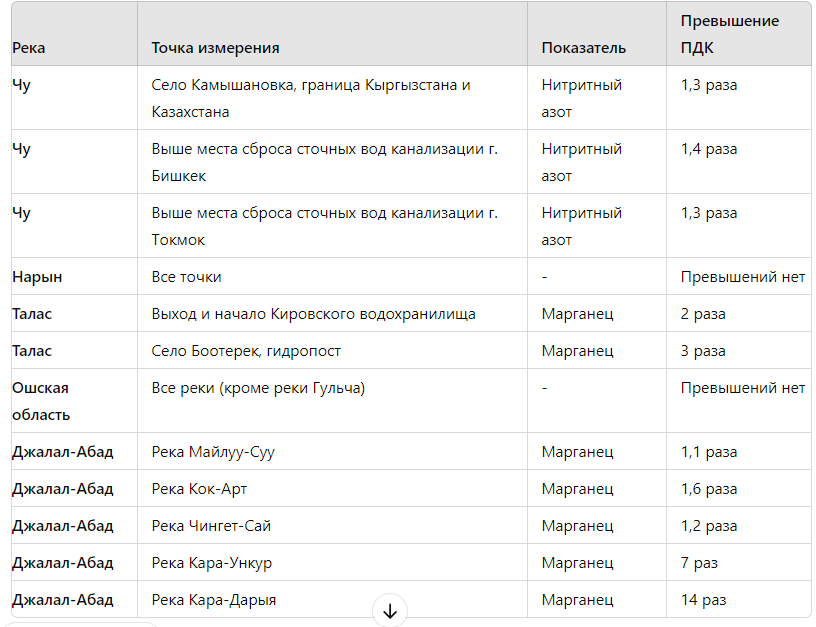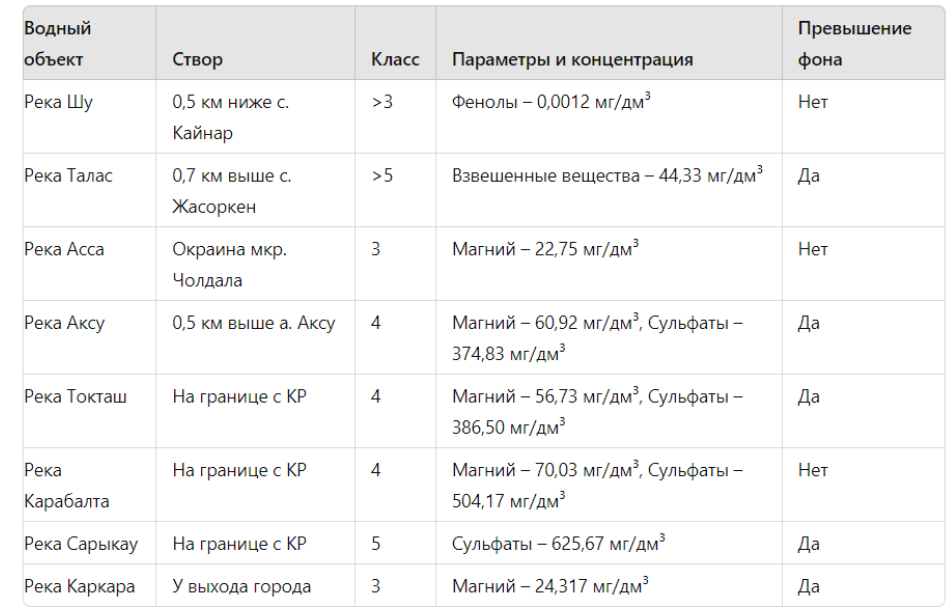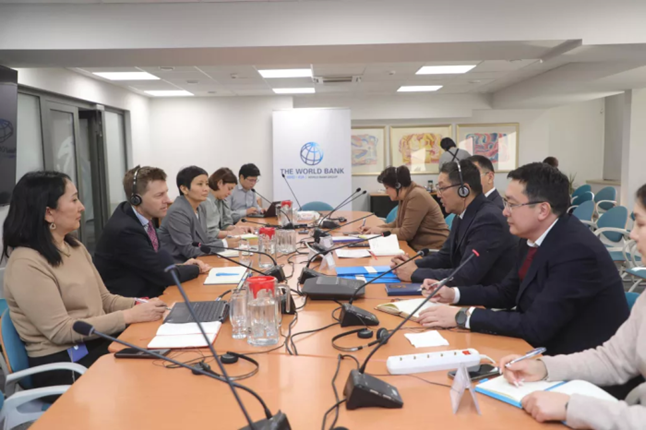In Kyrgyzstan, where the largest transboundary rivers of Central Asia originate, monitoring of river pollution remains insufficiently effective. According to available data, water pollution slightly exceeds standards for some indicators. However, in neighboring Kazakhstan, the situation is more alarming: pollution of the Chu and Kara-Balta rivers, which flow out of Kyrgyzstan, is significantly higher.
In Kyrgyzstan, all rivers cross borders
In Kyrgyzstan, all rivers, with the exception of the rivers of the internal Issyk-Kul basin, are transboundary. The largest transboundary rivers of Central Asia originate on the territory of the republic: Amu Darya (35%), Syr Darya (about 80%), Chu (78%), Talas (90%), Tarim (partially) and Karkyra.
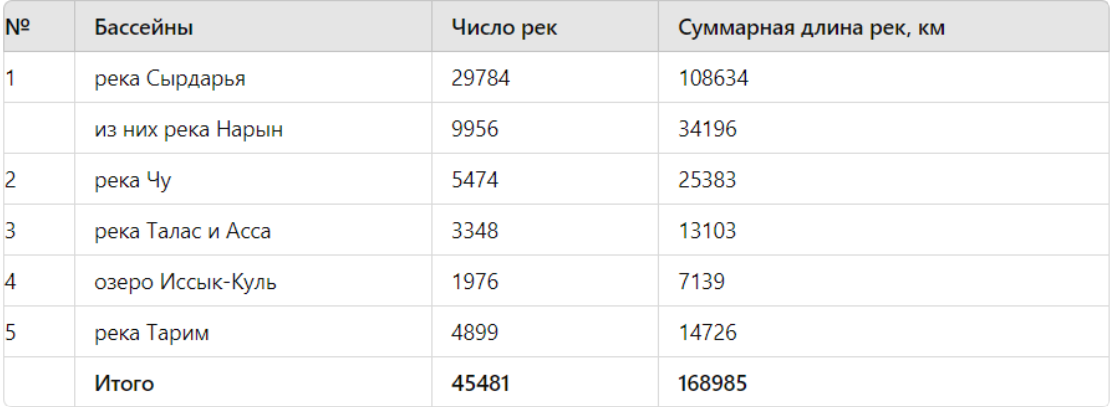
According to the Water Resources Service under the Ministry of Agriculture, the country’s water resources are used at 20-25%, the rest goes to Kazakhstan, China, Tajikistan and Uzbekistan.
Domestic and drinking water supply accounts for 3% of the total water intake, 93% is used for irrigation of agricultural crops, and 4% goes to industrial needs, mainly in Bishkek.
Kyrgyzhydromet: water in rivers is clean
Kyrgyzhydromet monitors the condition of surface waters on the Chu River and its tributaries (23 cross-sections) monthly, in the Chu-Talas river basin (8 cross-sections) 3-4 times a year. Analyses are conducted on 34 hydrochemical indicators. The physical properties of water, gas composition and main ions, as well as organic substances, including pollutants, biogenic components and pollutants of inorganic origin are determined.
The Chu River is the largest water body in the Chu Valley, the chemical composition of which is formed under the influence of both natural factors and anthropogenic activity. According to hydrochemical features, the river is conventionally divided into three sections: the upper reaches, the middle reaches, and the lower reaches.
As reported by Kyrgyzhydromet to CABAR.asia, according to data for 2023, in the upper reaches, the concentrations of pollutants are within the permissible values. Pollution is recorded mainly in the middle and lower reaches. In the catchment area of the lower reaches, saline soils are common, which increases the mineralization of water, increasing the concentrations of sulfate ions, BOD5, mineral phosphorus, ammonium nitrogen ions and nitrite nitrogen.
” In the period from 2018 to 2023, there has been a gradual increase in the values of the water pollution index along the Chu River and its tributaries, but the average indicators correspond to quality class II – the water is clean. Self-purification processes in the water of the Chu River and its tributaries play a significant role in improving water quality , ” concluded Kyrgyzhydromet.
The water of the Kara-Balta River in the upper reaches is assessed as clean. In the lower reaches, on the border with Kazakhstan, the mineralization and hardness of the water are increased due to the natural nature of saline soils. The ecological state of the Talas River in Kyrgyzstan meets quality standards.
Ministry of Ecology of the Kyrgyz Republic: nitrogen and manganese exceed standards on the border with the Republic of Kazakhstan
The Department of Environmental Monitoring under the Ministry of Natural Resources, Ecology and Technical Control also monitors the quality of water in rivers. Chemical studies have revealed that the maximum permissible concentrations of nitrite nitrogen and manganese have been exceeded in several rivers in Kyrgyzstan, with the most significant excess of manganese in the Kara-Unkur and Kara-Darya rivers.
Source: Department of Environmental Monitoring under the Ministry of Natural Resources, Ecology and Technical Control
Kazakhstan: Trans-border rivers flow with toxic waste
According to statements by official relevant bodies of Kazakhstan, the situation with transboundary rivers here is not so favorable. According to the Kazhydromet report for the first half of 2023, the water in the Kara-Balta River is not suitable for all types of water use due to high natural concentrations of some chemicals. The situation in other monitored rivers, according to the Kazakh side, also leaves much to be desired.
Source: Kazhydromet
Possible sources of pollution
Kazhydromet notes that in the spring season of last year, the most polluted with chemical elements were the riverbeds of the Shu (Chu) and Kara-Balta. The sources of pollution are probably waste from industrial ore processing at the Ak-Tyuz deposit and the radioactive waste storage facility at the Kara-Balta mining plant in Kyrgyzstan, Kazakh specialists believe.
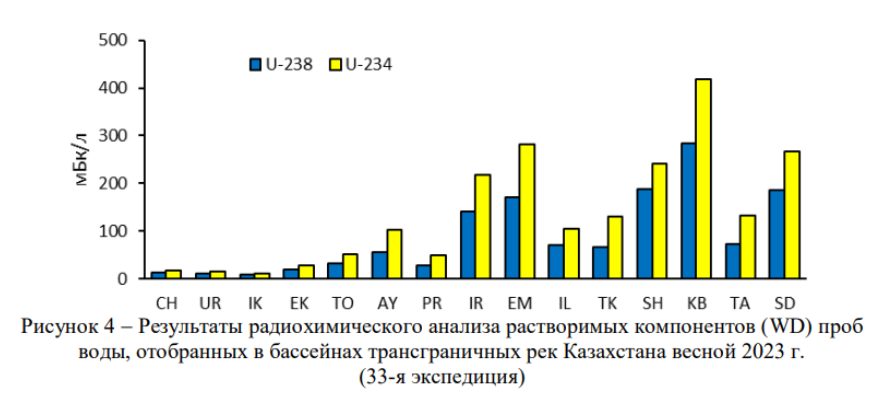
“Figure 4 shows the values of the concentration of uranium isotopes U-238 and U-234 in the waters of all monitored transboundary rivers of Kazakhstan in the spring of 2023 in the form of a graph. It is evident that high values of concentrations of these radionuclides correspond to the rivers of Southern and South-Eastern Kazakhstan: Syr Darya, Talas, Emel, Irtysh (IR), Shu and, especially, Kara-Balta. Given the significant amount of radioactive waste generated by specialized enterprises (Kara-Balta, Ak-Tyuz, Vostokredmet, etc.) located in the basins of these rivers, constant monitoring of the radionuclide and elemental composition of their waters is necessary,” the report says.
As reported by Kyrgyzhydromet, the formation of the chemical composition of the river water occurs under the influence of both natural factors and human anthropogenic activity.
“An analysis of the dynamics of water quality in water bodies in the Chui region showed that the greatest negative impact on the hydrochemical regime of water bodies was exerted by sectors of the national economy, economic and other objects. These include: cities and towns, agricultural lands, hydraulic structures, artificial reservoirs and canals, ground transport highways, unequipped storage facilities for household and industrial waste,” noted Kyrgyzhydromet.
Why the data differs
As explained by Kyrgyzhydromet for CABAR.asia, the water quality assessment criteria in Kyrgyzstan differ from the classification system in Kazakhstan. These systems cannot be compared, as they use different approaches and methods for assessing water quality.
Kyrgyzhydromet specialists emphasized that in addition to differences in methods, there are also natural factors that affect water quality. For example, in the lower reaches of the Kara-Balta River, the soil is heavily saline, which increases the mineralization and hardness of the water. This also leads to increased sulfate and magnesium content in the water.
The databases are old and there are not enough laboratories.
As noted in the National Water Strategy of the Kyrgyz Republic until 2040 , until 1992 the Kyrgyzhydromet monitoring system included 148 hydrological posts on rivers and 7 on lakes and reservoirs. Currently, 78 hydrological posts on rivers, 5 lake posts, 4 posts on Lake Issyk-Kul and 1 on the Kirov Reservoir are functioning. Of these 78 posts on rivers, 8 (10%) require complete restoration, 20 (26%) are in a state of emergency, and about 30% of service premises require major repairs.
“Kyrgyzhydromet monitors the quality of surface waters only on the Chu River. The laboratory base does not meet modern requirements for accreditation. There are only two environmental laboratories in Bishkek and Cholpon-Ata, which emphasizes the need to create laboratories in the south of the country. Departmental laboratories need technical re-equipment and updating of the instrument base,” the national strategy notes.
Kyrgyzhydromet reminded that upgrading the laboratory is a slow and labor-intensive process. The equipment is being upgraded in stages.
“The laboratory has been significantly improved in recent years. A mobile hydrochemical laboratory was purchased as part of a World Bank project, which improved the accuracy of analyses and the number of measured water parameters from 27 to 34. Also, as part of a Finnish-Kyrgyz project, the laboratory received technical support for a more accurate assessment of the quality of surface water in the country,” the institution assured.
Treatment facilities do not perform complete biological treatment
Treatment facilities and wastewater play an important role in controlling the situation on rivers. There are 145 treatment facilities in Kyrgyzstan, 22 of which are municipal. Due to lack of funding and technical equipment, many operate in mechanical treatment mode, without performing full biological treatment.
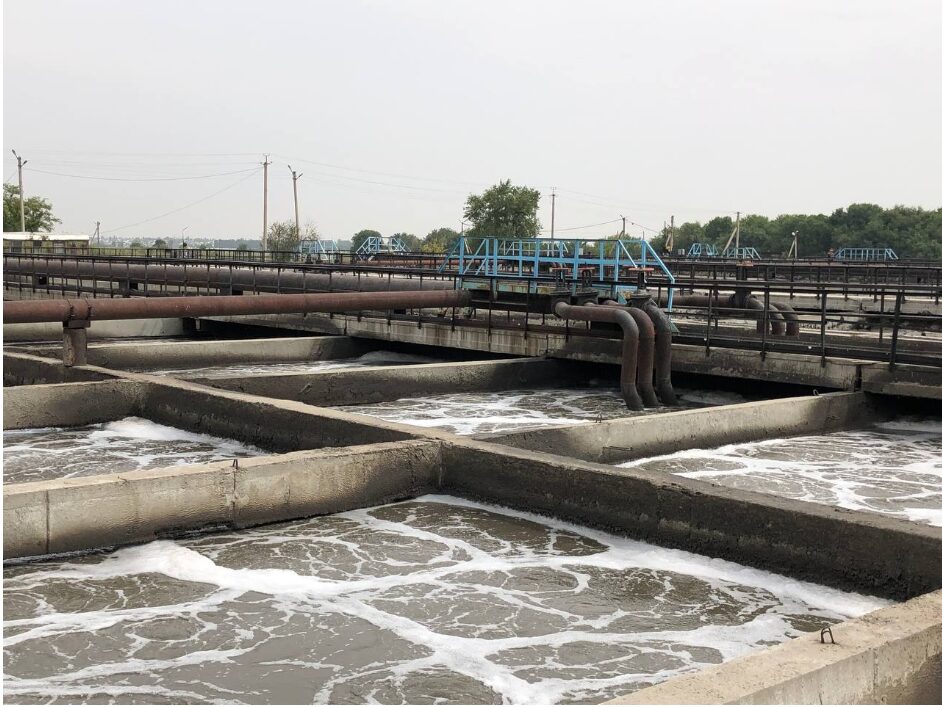
After passing through treatment facilities, wastewater is discharged into the environment. Mowgreen clarified that out of 145 wastewater treatment facilities, 14 discharge into surface water bodies, 5 into dry river and stream gullies, 2 into the terrain, 114 into irrigation and collector-drainage systems, 10 into filtration and evaporation fields.
Another problem is that only 42% of the country’s population has sustainable access to sewerage. In rural areas, there are no communal sewerage systems, and wastewater is discharged into the environment without proper treatment.
“The exceptions are the Chui and Osh regions, which directly surround the cities of Bishkek and Osh. However, here too the situation is complicated by the fact that internal migration processes have led to a high concentration of population in Bishkek. As a result, rings of new buildings have appeared around the capital, which are not provided with sewerage systems. The accumulation and unregulated discharge of domestic wastewater from residential buildings is carried out into the collector-drainage network, onto the terrain and into water bodies, which leads to the pollution of both underground and surface waters,” the environmental public organization ” Muvgrin” notes .
According to the National Statistical Committee , more than 132 million cubic meters of wastewater are discharged into water sources in Kyrgyzstan every year. Of these, 1.7 million cubic meters or 1.3% are polluted wastewater (without treatment and insufficiently treated).
“At the same time, the presented discharge of untreated and insufficiently treated wastewater into water sources across the territory is not an indicator, since not all enterprises that have sewage treatment facilities on their balance sheet provide information to the NSC. In addition, discharges of wastewater from decentralized wastewater disposal systems in rural areas are not taken into account,” explained Mowgreen.
The Chu River is the most polluted by salt return waters
After irrigation, the water that has not been absorbed into the soil flows off the fields and into special channels and drainage systems. These waters, called collector-drainage waters, contain high concentrations of sulfates, chlorides, and sodium ions. Through drainage systems, they enter rivers, which leads to pollution of water bodies.
According to the environmental organization “Movegreen”, in the Chui region the collector-drainage flow is 875.8 thousand cubic meters, which is equal to 73% of the total volume in the republic. Return water from the fields, saturated with salts, significantly affects the chemical composition of the Chu River and its tributaries.
Collector-drainage waters also contain pesticides and nitrogen and phosphate compounds. Up to 25% of nitrogen and 5% of phosphates from the amount introduced are carried into collectors from irrigated fields, which significantly exceeds the influx of salts into water bodies, the environmental organization reports.
All tailings dumps will be reclaimed by 2030
According to the National Security Concept of the Kyrgyz Republic , there are 92 facilities in the country that contain 250 million cubic meters of radionuclides and other toxic substances.
They pose a high risk of radiation-hazardous transboundary environmental disasters, in the zone of which are located the territories of Kazakhstan, Tajikistan and Uzbekistan, where over 7 million people live.
As Asel Seitkazieva , Deputy Director of the Department for Tailings Management, told Cabar Asia that all tailings will be reclaimed by 2030. This concerns 60 facilities on the balance sheet of the Ministry of Emergency Situations, the remaining 32 are located on the territory of operating enterprises.
“Reclamation of tailings in the village of Kadji-Sai in the Issyk-Kul region has been completed, and this year it will be completed in the village of Min-Kush in the Naryn region. All this was done within the framework of an interstate program. Russia allocated 70% of the funds for its implementation, Kazakhstan – 15%, and Kyrgyzstan and Tajikistan 5% each,” she noted.
Seitkazieva added that it is planned to carry out the reclamation of five tailings ponds in the Osh, Jalal-Abad and Batken regions using a grant from the Russian Federation.
“As part of the reclamation work, we are strengthening dams and moving tailings ponds located directly on the banks of rivers, transboundary rivers. For example, in Min-Kush and Shakaftar, tailings ponds have been moved far beyond the boundaries of populated areas, and we are planning to do the same in Mailuu-Suu. This will completely eliminate the risks of pollution of the environment, water resources and ensure the safety and health of the population,” she explained.
Does the reclamation of all tailing dumps guarantee complete environmental safety for Kyrgyzstan and the region? “No,” Seitkazieva answers, “no one will give a 100% guarantee. It is important to remember that Kyrgyzstan is a mountainous country with climate risks. But the Department for Tailings Management conducts regular monitoring and control, which allows for timely identification and elimination of possible problems, maintaining the safe condition of the reclaimed areas.
Comprehensive measures are needed
According to experts, first of all, it is important to strengthen monitoring and control of the state of water bodies. To do this, it is necessary to modernize the existing infrastructure of hydrological posts, increase the number of observation points and provide them with modern equipment. It is also necessary to introduce new analysis methods that meet international standards.
The second step is to improve treatment facilities and sewerage systems. An active environmental policy and cooperation at the international level are also necessary. Transboundary cooperation and joint efforts will help keep rivers clean and safe for future generations.
And here we should not forget about the protection of water protection zones. As ecologist Sergey Krivoruchko says , compliance with the land use regime within water protection zones is not only connected with ecology. Now it is also connected with emergency situations.
According to the current legislation, the exclusion zone or water protection zone is determined by local representatives. But this approach is not always correct, since there is often a shortage of specialists on the ground.
“For example, on Issyk-Kul, Aksu and other rivers, it is clear that yurts are being set up on the river banks, vegetation is disappearing, and bushes and trees protecting the reservoir are being cut down. People can set up temporary accommodation, set up cafes and toilets, which is against the law. As a result, such actions increase the risk of water pollution and reduce their quality,” the ecologist concluded.
https://cabar.asia/ru/kyrgyzstan-neobhodimo-obnovit-sistemu-monitoringa-rek

